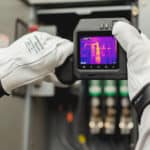What is an Arc Flash Study?
To understand the importance of arc flash hazard assessments, you must first understand the risk arc flashes pose to your people and facility. An arc flash is a heat and light that results from an arc fault — a discharge caused by a low-impedance connection to the ground or another voltage phase in an electrical system. This occurs when gas experiences an electrical breakdown, producing a bright, plasma-based discharge that’s extremely hot — often hotter than the Sun — and can cause immediate harm and even death to those nearby. Injuries caused by an arc flash include skin burns, respiratory issues, hearing loss, eye damage, and more.
This is distinct from an arc blast, which is a shockwave that can result from the same arc fault yet occurs when the metal in the conductors is vaporized. This can produce damaging and even lethal debris and hot metal. While appropriately rated personal protective equipment (PPE) can protect workers from arc flashes, the same cannot be said when it comes to an arc blast because of what the worker might come into contact with as a result of the explosion.
For safety managers, plant managers, and other facility workers, it’s critical to understand what an arc flash study is and why it’s so important. Not only do arc flashes present a significant danger to your employees, but they can also cause damage to your electrical assets and the surrounding environment — particularly if there is sufficient energy within the arc fault to cause a blast rather than a flash. And they can result in extremely costly regulatory fines, insurance premium increases, and more.
Related Posts About Arc Flash
With an arc flash hazard assessment, companies using electrical equipment — whether in a production environment or just part of their facility’s infrastructure — can better understand the amount of energy that could be released as a result of an arc flash. The goal of this assessment is four-fold:
- To establish a flash protection boundary around the source
- Determine the level of arc-rated apparel and other PPE needed
- Improve and maintain compliance with industry regulations
- Ensure all assets are properly documented and labeled
What Goes Into an Arc Flash Hazard Assessment?
Because arc flashes often occur from minor oversights, an ideal arc flash hazard assessment should consider a number of risk factors that might not be immediately obvious to safety managers, facility supervisors, and employees. These include:
- The presence of dust and condensation within or on an electrical asset
- Accidental contact with an asset due to poor training or lack of signage
- The mishandling of tools resulted in conductive items being left near live assets
- The presence of condensation within electrical assets
- Electrical asset corrosion and faulty installation
The service begins with an on-site electrical systems equipment assessment in which inspectors will uncover potential correctable issues within your distribution system. Inspectors will identify available short circuit currents and each asset’s interrupting time. From here, they will calculate the largest incident energy at the specified working distance. This calculation enables inspectors to determine the arc flash boundary and hazard risk category.
Once the boundary and category have been established, the inspectors can make recommendations to help reduce the incident energy level and determine the appropriate PPE required to work around the assets. All results are documented, and labels can be generated for the equipment. These labels provide location-specific safety information for employees and ensure your organization follows National Fire Protection Agency (NFPA) standards to improve employee safety when working on or near exposed live electrical parts.
How We Take Arc Flash Hazard Assessments to the Next Level
At SEAM Group, we partner with organizations worldwide to help them with their arc flash hazard assessment needs. But we go far beyond simply detecting anomalies and placing labels on electrical assets. While labels are important for communicating safety information, much more can and should be done to protect employees and your bottom line.
Additionally, we place such a high emphasis on arc flash hazard assessments because so many organizations are still not in compliance with the latest update to the National Fire Protection Association (NFPA) 70E workplace safety standard that governs in this area. While the most recent revision occurred in early 2018, many companies are still not meeting its basic requirements or its three newest ongoing best practices (PPE declarations, job safety plans, and equipment condition/maintenance). Following these guidelines is not only the ideal solution for maintaining compliance with Section 5(a)(1) of the Occupational Health and Safety Act but also helps to prevent the hazards that can come as the result of an arc flash.
To help your organization understand and prioritize the results of your arc flash hazard assessment, we offer ViewPoint® — our web-based management solution that centralizes your assessment data in one spot. Whether you have a single facility or dozens, all asset data is collected and input for analysis. The main benefit of ViewPoint is a high-level overview of your results and in-depth details on asset conditions. This provides an unparalleled level of information as well as prioritization to help you make the best decisions possible.
Achieve Your Safety Goals with SEAM Group
While electrical incidents have decreased nationwide in recent years, industry regulations continue to expand and pressure organizations to reduce them even further. Don’t leave this important safety process to chance. Let SEAM Group help you maintain compliance while also enhancing the protections you offer to your employees. Speak with an arc flash hazard expert today.th





